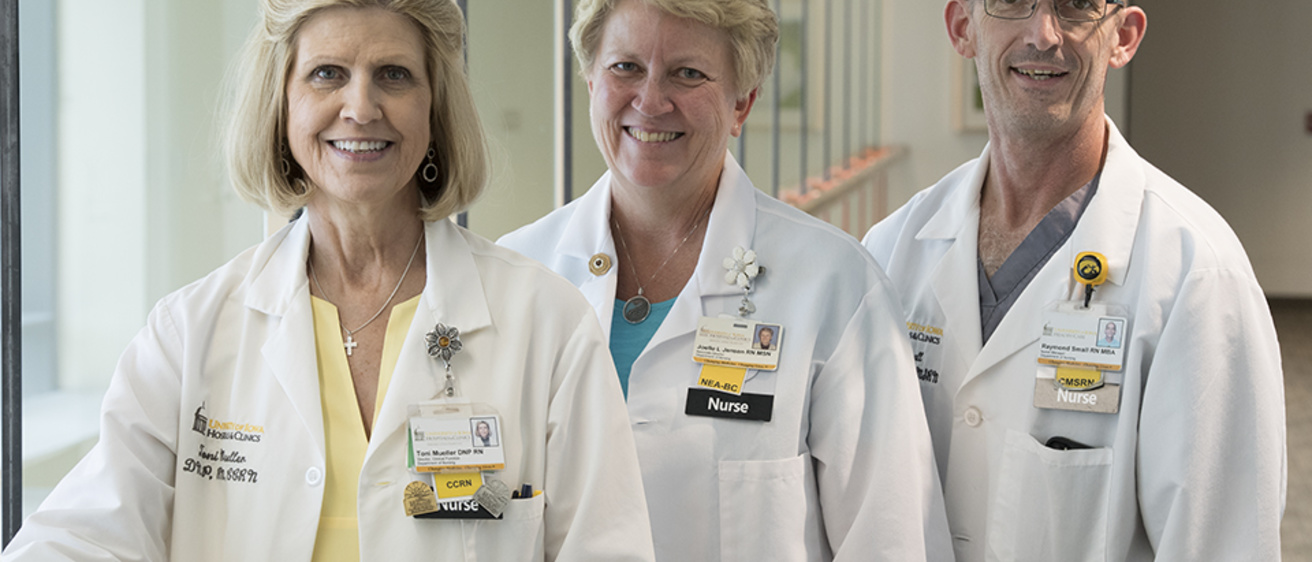Editor's note: During June 2008, the University of Iowa sustained the worst natural disaster in its history when severe flooding sent the Iowa River over its banks and into the campus and Iowa City communities. As the UI celebrates near completion of its flood recovery efforts this fall, Iowa Now looks back at that challenging time when thousands of faculty, staff, students, and volunteers joined forces to ensure the UI remained open for business. This is just one of many inspiring stories.
The Hospital Incident Command System (HICS) at University of Iowa Hospitals and Clinics conducts quarterly drills designed to keep its several dozen team members prepared in the event of an emergency.
In the middle of June 2008, the HICS members met often, sometimes twice a day. It wasn’t a drill.
The hospital—like the rest of Iowa City, Coralville, and the surrounding area—was bracing for what would become the worst flood in Johnson County history. On June 15, 2008, the Iowa River crested at 31.53 feet—well above the 25 feet considered “major flood stage.” Only two days earlier, the Cedar River in Cedar Rapids crested at 31 feet, 11 feet above its previous high-water mark. All along its path, the Cedar spilled from its banks, closing and washing away roads.
During the week of June 8, as predictions about how high the water would rise came in, the HICS team met daily and sometimes more in order to identify risks and discuss and strategize imminent needs.
The flood of 2008 affected more than 2.5 million square feet of building space at the University of Iowa (the equivalent of one-sixth of the campus), forced the evacuation and closing of 20 buildings, and resulted in $743 million in damage and recovery costs.
This fall marks completion of three major construction projects affiliated with recovery efforts—the Art Building replacement, the Voxman Music Building, and Hancher Auditorium. The UI Museum of Art replacement is the final flood recovery project. Officials hope that building will open in 2019.
The hospital employs more than 10,000 people, including nearly 1,700 physicians, residents, and fellows, and close to 2,000 professional nurses. Staff members come from across eastern Iowa and western Illinois, typically within a 100-mile radius of Iowa City—many from areas that were being impacted by overflowing creeks. Even before the Iowa and Cedar rivers left their banks, many county roads were closed—in some cases washed away. Major portions of Interstate 380 were closed between Iowa City and Cedar Rapids; HICS identified alternate routes and communicated with staff.
The other main entry to Iowa City from the east is Interstate 80, a major thoroughfare for many staff and patients needing to get to UIHC. However, portions of the interstate between Iowa City and the Quad Cities had washed away. The HICS team discussed the impact this situation presented. Patients, families, and staff couldn't get out of Iowa City, and teams of medical personnel and patients in need of care couldn't reach the hospital.
This was one challenge the team needed to solve.
“Staffing was one of our biggest challenges, not knowing exactly what we were going to be faced with,” says Toni Mueller, director of critical care at the hospital.
Hospital administration was aware that many staff members were worried about their own homes, property, and families while working extended shifts during the crisis. A big logistical challenge remained: How would medical personnel get to and from Iowa City when roads to the north and to the east were closed?
“We had to talk about all kinds of difficult ways of getting people here,” says Ray Small, nursing manager in the Department of Urology. During those discussions, John Staley, senior associate director at UIHC, suggested the hospital find a way to fly employees back and forth from Cedar Rapids and the Quad Cities.
So that’s what they did.
“Once we heard that idea, we all knew that was it, that’s what we needed to do,” Mueller says. “Making sure people had a safe way to travel was a top priority to meet patient needs and have the ability to get staff home to assess their needs during this time.”
They put a plan into place. Planes arrived at the Iowa City airport twice a day, at 7 a.m. and 7 p.m., and then departed for Cedar Rapids and Moline, Illinois. The planes became an important asset to hospital operations, thanks to the work done by Staley.
“It wasn’t just about getting nurses to work, but about getting the supplies we needed here too—food, water, things we needed to keep going,” says Joelle Jensen, director of Throughput and Patient Flow Services, who helped orchestrate the air travel. “Having the planes available was huge.”
Communication was also key: Staff needed to be called with their departure information, and they needed a seat on the plane. The timing of each element of the plan was important, and as the situation unfolded, everything went like clockwork.
“People just rallied and did whatever they could to help,” Jensen says. “Whenever there’s a crisis, people just seem to come out of the woodwork to help out.”
Having the “air taxi” available did more than get people to work, Jensen says. It helped the hospital run efficiently and seamlessly during a difficult time.
“The bottom line was really keeping patients safe and getting staff back and forth safely,” she says. “Once everyone was here, the teamwork they all showed in making sure patients were comfortable and cared for was incredible. I just can’t stress enough how much the team just really came together—for the hospital and for each other.”
The University of Iowa will celebrate the grand opening of the new Hancher Auditorium on Friday, Sept. 9; the grand opening of the new Visual Arts Building on Friday, Oct. 7; and the grand opening of the Voxman Music Building on Friday, Oct. 21. For details about the events, visit inspire.uiowa.edu.
